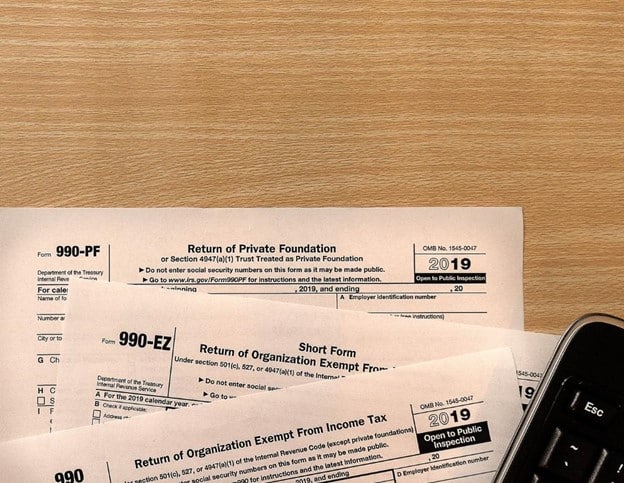We get it. You’re running a nonprofit, not a business. But, if you want to keep that tax-exempt status, you need to follow the rules set by the Internal Revenue Service (IRS). Because the IRS grants tax-exempt status, it can take it away. Without the nonprofit status, you may have difficulty achieving your mission.
People assume that the IRS rules only pertain to financial matters, but that’s not completely accurate. Some tax rules require specific organizational structures and recordkeeping. The best way to ensure compliance is to have an understanding of the principles that pertain to nonprofit accounting.
For example, the composition of a nonprofit board of directors is extrapolated from other rules, so it’s difficult to find a specific place in the IRS tax code where it limits the number of blood relatives who can sit on a public charity board. However, it is understood that 51% of the board must be unrelated. The relationship among board members attending a meeting determines whether a quorum has been met.
In this guide, we discuss five areas where for-profit and nonprofit differ. We discuss why these areas form the foundation of what is unique to nonprofit accounting. The guide provides an overview of nonprofit accounting to help those new to the sector understand how accounting directs operations.
Board of Directors
The IRS requires that a nonprofit have a board of directors. It does not stipulate the number or term length; however, you should keep in mind that the IRS is concerned that:
- Board members, executives, and officers do not receive financial benefits that exceed the benefit the nonprofit receives from its service.
- Private benefit does not outweigh the public benefit of the nonprofit.
In other words, the IRS wants to ensure that charitable donations are benefiting the charitable cause more than the charity. Poorly constructed boards can trigger IRS audits.
Board Terms
The number of board members should be set in the by-laws and should always be an odd number. With an odd number, there will always be a tie-breaking vote. It is also a good practice to set term limits. For example, a board member could serve a maximum of two consecutive terms of five years for a total of 10 years.
Board Composition
When selecting board members, consider having people with financial and legal backgrounds. They can help ensure that the accounting is performed correctly and can provide legal direction as needed. Community leaders can help with fundraising and are excellent choices for board members. Founders often sit on boards, but a nonprofit must be sure that the board’s makeup does not trigger an audit.
Board Responsibility
Board members of nonprofit organizations have a fiduciary responsibility to the organization, whether compensated or not. State laws may vary, but their duties will correspond to the IRS tax code for board composition. Boards have three duties:
- Duty of Loyalty. A Board of Directors must act in the best interests of the organization.
- Duty of Care. Boards must oversee the organization’s financial and operational activities using reasonable care.
- Duty of Obedience. They must act as determined by the organization’s charter, bylaws, and mission.
Individual board members who fail to perform their fiduciary responsibility can be held liable for financial harm. Many nonprofits and their boards fail to understand the significant responsibility individuals bear when working with nonprofits.

Internal Controls
Every organization — for profit or not — needs written policies and procedures that outline how tasks are performed and what behaviors are expected when representing an organization. These documents are often called employee handbooks, marketing guidelines, or department procedures.
The IRS wants to ensure that donated funds are not misused. When setting up accounting procedures, nonprofits need to make sure they can provide the transactional transparency that the IRS requires. Having controls in place that segregate financial duties minimizes the risk of mismanagement and reduces the odds of an audit.
Policies and Procedures Manual
The following outlines the recommended sections to include in a policies and procedures document:
- Division of Responsibilities
- Chart of Accounts and General Ledger
- Cash Receipts
- Interaccount Bank Transfers
- Cash Disbursements and Expense Allocations
- Bank Account Reconciliations
- Property and Equipment
- IRS Form 990
- Financial Reports
- List of Financial Forms and Purpose
With well-documented procedures, nonprofits can provide the transparency that the IRS requires to ensure funds are being properly managed.
Segregating Duties
Segregating financial duties limits the control an individual has over a transaction or operation. For example, the person who receives donations should not be the same individual who records them in the accounting system. Managers with check writing authority should not have access to funding assets, and the board of directors should provide oversight of the entire process. Separation of financial duties is central to meeting the IRS transparency standards, especially in the areas of donation and disbursement.
Donations
Suppose an organization receives check donations through the mail. Two people are present as checks are received and endorsed with a “for deposit only” stamp. Checks and deposit slips are copied and the copies filed. The deposit is made, and the receipt is returned. Using a two-person process reduces the chance of a miscalculation or an overlooked donation.
A third individual records the donations in the accounting system, ensuring that the amount recorded matches the deposited amount. The board of directors reviews the financials to avoid the possible mishandling of donations. With adequate controls in place, nonprofits can comply with the IRS transparency requirements.
Alternatively, organizations could use lockboxes to have the donations sent directly to a PO box that is managed by a third party, usually a financial institution. The checks are delivered to the lockbox. They are scanned and deposited into the stipulated account. The nonprofit can access that information through online banking services or wait until a statement is received. Automating the process through a lockbox not only reduces staffing requirements but also ensures a separation of accounting duties.
Disbursements
Segregating duties also apply to paying bills and other expenses. Internal controls should have expense policies that limit how much different people are authorized to spend without additional approval. The accounting manager may be given authority to disburse up to $3,000.00, which covers routine expenses. The director can approve expenditures up to $15,000.00. Expenses above $15,000.00 require board approval.
Nonprofits could also control expenditures through budgetary constraints. For example, a bookkeeper could pay expenditures up to the budgeted amount. Anything above that threshold would require approval. Expenditures not in the budget would need board approval.
Organizations should also have internal controls regarding petty cash and expense reimbursement. Each control should clearly outline the segregation of duties to minimize opportunities for fraud or mismanagement. If the same individual is responsible for receiving, entering, and paying bills, it provides an opportunity for someone to create a nonexistent vendor that receives periodic payments for nonexistent goods or services.

Financial Statements
Nonprofits need financial statements just like for-profit organizations. Grant applications often require them, as do auditors. A board of directors should demand that financial statements are available for review monthly. Financial statements provide a view into the financial health of an organization at a specific point in time. Although for-profit and nonprofit statements provide the same information, they are named differently.
Nonprofit financial statements include:
- Statement of Financial Position (SOP). This report is the equivalent of a for-profit balance sheet.
- Statement of Activities. This statement is the equivalent of a for-profit income statement.
- Statement of Functional Expenses. For-profits have the option of providing details on their expenses as part of their financial statements. Nonprofits do not. They need to produce a detailed listing of expenses.
- Statement of Cash Flows. Cash flow statements show the movement of funds from revenue sources through to liabilities.
Each statement helps nonprofits remain financially sound; however, individuals must understand how to read the reports to receive maximum benefit.
Statement of Financial Position
A balance sheet shows assets and liabilities. Assets are cash, grants, and depreciable equipment and furnishings. They are listed in order of liquidity or how quickly the assets can be converted to cash. Liabilities include debts, accounts payable, and funds due to other organizations. Liabilities should be listed based on the length of obligation or how long the debt has been outstanding.
Contributions are listed separately in an SOP according to category. Unrestricted or restricted may be sufficient; however, temporary or permanent restricted funds should be separated if present. An SOP is a snapshot of your financial health where assets should outweigh liabilities.
Statement of Activities
A statement of activities shows asset changes over time. It shows increases in revenue as donations or grants or made. Liabilities reflect the decreases in assets as bills are paid. As with the SOP, assets are separated into donor restrictions and without donor restrictions. Noncash income such as donated goods can be recorded under revenue.
Activity statements can introduce complexity for such issues as donated services or goods. Generally accepted accounting principles (GAAP) may treat donated goods and services differently than the IRS. Having someone with nonprofit financial experience can help avoid inadvertent errors that often plague 990 forms.
Statement of Functional Expenses
Functional expenses are expenses grouped according to purpose. For example, expenses may be classified as administrative, programmatic, or fundraising. More detail can be provided if expenses are also identified by type. Rent and utilities could appear under administrative, while advertising costs could be listed under Fundraising.
Showing expenditures allows board members to determine if the administrative costs are out of balance compared to program expenses. If the administrative salaries are low, it could explain why programs or fundraising are not meeting expectations. More staff may be needed.
Expenses can appear in more than one place. For example, utilities might be split between program and administrative expenses. However, they would need to be proportioned according to usage.
Statement of Cash Flows
Cash flow shows the cash position of a nonprofit at a given moment. It shows the cash coming in and going out. It can be configured to show different details, but three areas that are typically included are:
- Income from investments.
- Income from fundraising or unrestricted donations.
- Financing activities, if applicable.
Being able to project income over a 30- or 60-day period makes it easier to assess an organization’s financial needs in advance.

Form 990
Although form 990 is not a financial statement, it is often referenced by nonprofit organizations. The form is an IRS form that must be completed every tax year. Failure to file places an organization out of compliance. The form shows a nonprofit’s revenue and expenses and outlines how funds were used. The IRS uses this form to determine whether a nonprofit is operating ethically.
Donor and Grant Restrictions
Nonprofit organizations’ requirements for boards of directors, internal controls, and financial statements aren’t a lot different than for-profits. They may be called different names or have different information, but their financial functions are the same. Donor restrictions are where the differences become noticeable. In essence, donor restrictions are money with strings attached.
Restrictions
Some of the financial statements have separate line items for contributions with donor restrictions and without donor restrictions. That’s because all donations, grants, and endowments must be tracked to ensure the funds are being spent appropriately.
- Unrestricted. These funds are available for general use. Most individual contributions are unrestricted, meaning the funds are not stipulated for a specific purpose.
- Restricted. Funds may be restricted for several reasons. They may be restricted by time or purpose. Some grants and endowments may have permanent restrictions that always apply.
Without proper record keeping, it is virtually impossible to determine whether the donations were properly distributed. With so many accounting software packages to choose from, there’s no reason for nonprofits to track donations manually.
Managing restricted donations begins the moment a grant or donation is received. Depending on the accounting program, a tag or identifier is assigned. Suppose ABC foundation received a $50,000 grant to run an after-school literacy program. The foundation needs to identify the award so that all expenses for the program can be coded against those restricted funds. If possible, a letter of the award with restrictions should be attached for easy reference.
Whenever funds are spent — whether it’s salaries or materials — the items need to be taken from the award money. If the program is being run out of a shared facility, utilities, rent, and maintenance can be billed to the award, but only in proportion to the occupied space. Tracking restricted funds can quickly become overwhelming when multiple awards are being managed. As with corporate taxes, there are many aspects of the tax code that are best left to professionals.
Donors
The IRS requires that nonprofits send donation acknowledgment letters to any donor who contributes $250 or more in a tax year. The letter is required for tax purposes. Accounting software should allow you to track donors by amount. Many programs may even produce an acknowledgment letter template. However, automating this process doesn’t help if the donor’s address was not captured at the time the gift was received.
Acquiring the donor’s address should be part of policies and procedures, so all staff knows to capture the data at the time of donation. If online gifts are accepted, the website administrator must ensure that the needed information is collected at the time the donation is made. Sending an acknowledgment letter may seem outside the scope of the IRS; however, it is an example of how important understanding nonprofit accounting is to nonprofit operations.
Revenue Recognition
All companies have a choice of two accounting methods — cash or accrual. Nonprofits may opt for cash because it seems simpler, but accrual may be the best choice, especially if funding sources include grants or endowments.
Cash
Cash accounting means reporting funds when they are received. For example, an end-of-year pledge drive earns $1,000 in pledges but only receives $700. The remaining $300 is not received until the next year. With cash accounting, the $700 appears in one year; the $300 in the next. Cash systems closely mirror cash flow, and nonprofits may start out using cash accounting.
The problem with cash accounting is it does not follow the GAAP recommendations, and it poses problems when an organization starts receiving grants. The IRS requires that nonprofits recognize the revenue received from a grant upon award. Suppose ABC foundation receives a grant for $100,000. The IRS requires the foundation to declare the entire $100,000 as revenue when the award is received. It doesn’t matter if the funds are dispersed over three years. ABC must accept the full $100,000 as revenue.

Accrual
Accrual accounting is more complex, but it is preferable to cash systems as nonprofits grow. Some states require annual audits of nonprofits. The federal government requires them if awards exceed $750,000. Finally, some bylaws stipulate periodic audits. Accrual accounting provides a more accurate financial picture than cash systems, which is why it is often required for auditing.
Accrual accounting recognizes income when it is earned (pledged) and incurs expenses when invoiced. When the actual funds are received, or a bill is paid doesn’t matter; the accounting system has already recorded the transactions at the time they were incurred. Although many people resist the accrual method of accounting, nonprofits that plan to grow should accept the inevitable and adopt the accrual method.

Budgets
For-profit and nonprofits need budgets. Without a budget, they have no way of knowing whether revenue will cover expenses or if assets will be available for growth. However, nonprofits often struggle to represent expected revenue since it is about how many widgets are sold.
Revenue
Historical data is the first place to start when calculating revenue. Using the historical data, nonprofits can look at each revenue source and assign a probability value to indicate whether that revenue will be available for the upcoming year. If the probability of receiving repeat funding is 75%, multiply the amount by 0.75. Repeat this process for each revenue stream.
Alternatively, combine all revenue sources into a total expected revenue. Multiply that amount by a probability value and use the result as your budgetary income. For example, the total estimated revenue based on historical data is $750,000. The probability value is 80%. Enter x as your budgeted income.
Expenses
Nonprofits can divide expenses across three expense categories — fundraising, administrative, and program. Others prefer to itemize budgetary expenses under expense categories. For example, a reimbursement entry may appear under fundraising and program but not under administrative. How expenses are tracked may also depend on whether a percentage of revenue is restricted. Again historical data provides an excellent starting point for budgeting expenses.
A Better Way to Nonprofit Accounting
Nonprofit accounting is more than debits and credits. It impacts your board composition and outlines the internal controls that are expected to protect your assets from fraud or misuse. With the IRS reporting requirements, the accounting process can determine whether you receive funding. Organizations are not going to give funding to nonprofits that cannot produce financial statements.
Nonprofit accounting firms know the why behind the how. It’s not just setting up a chart of accounts and coding items to the correct account. It requires an understanding of how the internal controls play into the IRS requirements to segregate accounting duties to prevent fraud or mismanagement. It means understanding the constraints that nonprofits often operate under — limited staff and untrained volunteers — and recommending solutions that protect assets while reducing staff workloads.
Technology can help with nonprofit accounting. Accounting software can make it much easier to prepare financial statements and ensure accurate bookkeeping. Depending on staffing, a nonprofit should look at a dual-entry system which can serve as another check and balance. Taking advantage of the built-in controls of accounting solutions can help provide the end-to-end transparency the IRS is looking for. Our virtual accounting solution leverages the latest technology to deliver nonprofit accounting services that focus on transparency and accountability. Schedule a discovery call to discuss how our virtual solution can help.

